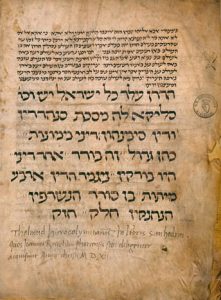Communal Organization: Social Services and Education
The Jewish community organizations of medieval western Christendom had to provide a network of social services. Jewish communities all across Europe created a variety of modalities for support of wayfarers, the poor, the aged, and the infirm. These agencies operated as constituent elements within the Jewish communal structure and as separate charitable operations funded through private donations. In the polemical give- and-take in which Christians and Jews sought to identify aspects of superiority, Jews regularly cited the largesse of their brethren toward those in need, contrasting Jewish caring with what was perceived as Christian callousness in dealing with those in need.
Jewish educational needs likewise had to be addressed by the organized Jewish community. Here, there were major differences between larger and smaller Jewish communities, with the former able to create more formal schooling structures and the latter forced to deal more informally with educational needs. Schooling was for males only, with instruction focused on Hebrew and Bible for younger students and then proceeding to rabbinic literature for more advanced students. In the early stages of the development of northern-European Jewry, advanced schools seem to have developed around the figures of especially revered scholars. Interestingly, in the wake of the crisis that struck Iberian Jewry at the end of the fourteenth and the early years of the fifteenth century, major communal reform focused considerably on strengthening the educational system, reflecting awareness of the importance of schooling for the well-being of the community and the maintenance of Jewish identity.
Images
Primary Texts
- Custom of R. Kalonymous, Ma`asei ha-Geonim
- Community Obligation for Orphans, Responsum of R. Meshullam ben Kalonymous
- Claims of Superior Jewish Social Services, Joseph Kimhi, Sefer Ha-Berit
- Education, Responsum of R. Gershom
- Claims of Superior Jewish Education, Joseph Kimhi, Sefer Ha-Berit
- Introduction to Primary Jewish Education, Sefer ha-Rokeah
- Introduction to Primary Jewish Education, Sefer Hasidim
- Education Regulations, Castile 1432 Communal Ordinance
Secondary Literature
- Y. Assis, The Golden Age of Aragonese Jewry- Community and Society in the Crown of Aragon, 1213-1327, 237-296.
- Ivan Marcus, Rituals of Childhood (New Haven- Yale University Press, 1998).
- E. Kanarfogel, Jewish Education and Society in the High Middle Ages (Detroit- Wayne State University Press, 1992).
- A. Grossman, Pious and Rebellious- Jewish Women in Medieval Europe, trans. J. Chipman (Waltham- Brandeis University Press, 2004).
- E. Baumgarten, Mothers and Children- Jewish Family Life in Medieval Europe (Princeton- Princeton University Press, 2004).
Videos
What do you want to know?
Ask our AI widget and get answers from this website
